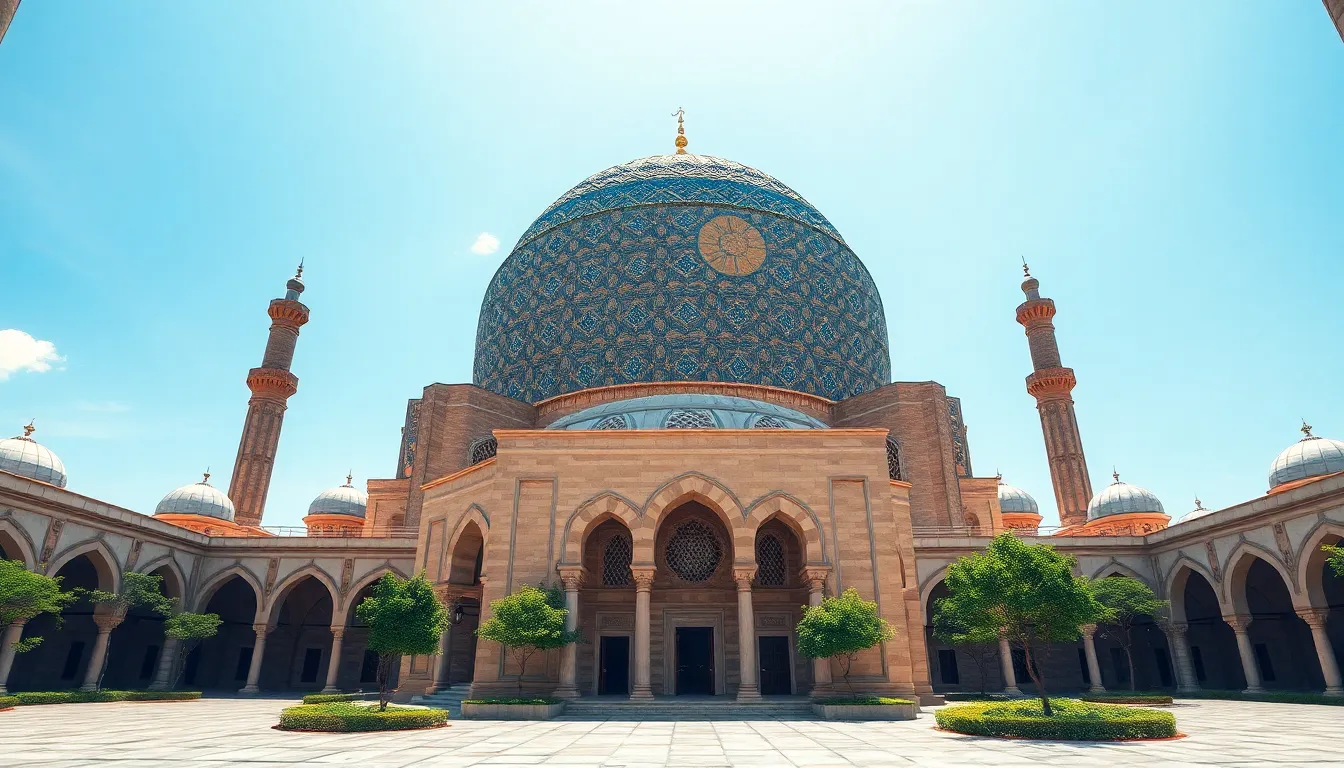When it comes to architectural wonders, <a href="https://tullochgroup.com/colombian-architecture“>Safavid architecture stands tall, quite literally. This stunning style, born during the Safavid dynasty in Persia, is like a grand feast for the eyes, blending intricate tile work with majestic domes and minarets that seem to touch the sky. It’s the kind of beauty that makes you want to trade in your boring office cubicle for a cozy corner in a Persian palace.
Table of Contents
ToggleOverview of Safavid Architecture
Safavid architecture flourished from the early 16th to the mid-18th century in Persia, representing a significant cultural shift. This style draws heavily from earlier Islamic architectural traditions, blending them with new elements to create something unique and striking. Noteworthy features include elaborate tile work, intricate calligraphy, and grand domes, each showcasing exceptional craftsmanship.
Mosques stand as prime examples of this architecture. The Sheikh Lotfallah Mosque in Isfahan exemplifies the harmonious blend of form and function. Its double-layered domes, adorned with colorful tiles, capture light beautifully, creating an ethereal atmosphere inside. Additionally, the use of extensive iwans—large vaulted spaces open to courtyards—demonstrates a commitment to both aesthetics and utility.
Palaces also showcase the grandeur of Safavid architecture. The Ali Qapu Palace highlights the era’s opulence, with its six levels emphasizing verticality and light. Lavish decorations are found throughout, including frescoes and intricate woodwork that enhance the visual experience.
Gardens reflect an integral aspect of Safavid design philosophy. Persian gardens, known for their geometric layouts and water features, symbolize paradise on earth. The Chahar Bagh Avenue in Isfahan incorporates garden aesthetics into urban planning, emphasizing harmony between nature and architecture.
Overall, Safavid architecture embodies the interplay between spirituality, power, and beauty. It not only represents the artistic achievements of its time but also influences subsequent architectural styles in the region. Each structure reveals a story within its walls, reflecting the ideals and aspirations of the Safavid dynasty.
Key Features of Safavid Architecture

Safavid architecture showcases unique characteristics that make it stand out. These features illustrate its significance in the Islamic architectural landscape.
Use of Geometry and Symmetry
Geometry and symmetry play pivotal roles in Safavid architecture. Architects created intricate designs using geometric patterns, which convey a sense of order and harmony. Buildings often include symmetrical layouts that enhance visual appeal. Courtyards and iwans, spaces framed by arched entryways, exemplify this approach. The double-layered domes dominate the skyline, merging functionality and aesthetics. In mosques like the Sheikh Lotfallah Mosque, this framework creates a peaceful environment, inviting deep reflection and spirituality.
Decorative Elements and Patterns
Decorative elements and patterns enrich the visual experience of Safavid structures. Tiles adorned with vibrant colors depict intricate floral and geometric motifs. Calligraphy often embellishes surfaces, conveying spiritual and poetic messages. The use of muqarnas, decorative stalactite-like features, adds another layer of complexity to ceilings and domes. The Ali Qapu Palace showcases lavishly decorated interiors, symbolizing the era’s artistic achievements. Water features in Persian gardens complement the architecture, reinforcing a seamless blend of nature and artistry. Each decorative detail tells a story, enhancing the cultural significance of the buildings.
Notable Safavid Architectural Sites
Safavid architecture features many remarkable sites that epitomize its grandeur. Prominent examples include Naqsh-e Jahan Square, Sheikh Lotfollah Mosque, and Ali Qapu Palace.
Naqsh-e Jahan Square
Naqsh-e Jahan Square serves as a central piece of Isfahan, showcasing the synthesis of art and architecture. This UNESCO World Heritage site measures approximately 160,000 square meters, providing ample space for public gatherings and celebrations. Surrounding structures, such as mosques and bazaars, enhance the square’s cultural significance. Intricate tile work and stunning calligraphy adorn the nearby buildings, reflecting the artistry synonymous with Safavid design. Visitors often admire the expansive layout, which incorporates fountains and gardens, symbolizing the Persian ideal of beauty and harmony.
Sheikh Lotfollah Mosque
Sheikh Lotfollah Mosque represents a pinnacle of Safavid architecture through its thoughtful design and exquisite details. Completed in 1619, it features a dome that reaches a height of 32 meters, captivating observers with its stunning mosaic tiles. The mosque’s entrance, adorned with intricate portals, leads to a serene prayer hall filled with mesmerizing light. Utilizing exquisite floral motifs throughout, artisans achieved a unique sense of depth and color. The mosque functions as not only a place of worship but also a testament to the religious and cultural aspirations of the Safavid era.
Ali Qapu Palace
Ali Qapu Palace stands as a symbol of Safavid opulence and architectural ingenuity. Positioned on the edge of Naqsh-e Jahan Square, this multi-story palace offers stunning views of the surrounding area. Constructed in the early 17th century, the structure combines splendid courtyards with intricately designed rooms, emphasizing verticality. Elaborate muqarnas adorn the ceilings, enhancing its grandeur and complexity. Visitors often find themselves captivated by the lavish balcony, which served as a stage for royal receptions and events, effectively blending functionality with aesthetic appeal.
Influence of Safavid Architecture
Safavid architecture profoundly influenced cultural and architectural developments throughout Persia and beyond.
Cultural and Historical Impact
The architectural achievements during the Safavid era played a significant role in shaping Persian identity. Major sites defined regional aesthetics, inspiring future generations of builders and artists. Iconic elements such as intricate tile work, expansive iwans, and double-layered domes became universal symbols of Islamic art. This period also marked a shift in architectural priorities, emphasizing spiritual connectivity with structural grandeur. The interplay between artistry and functionality left an indelible mark on Persian culture.
Legacy in Modern Architecture
Modern architects often draw inspiration from Safavid architecture in their designs. Current structures frequently utilize elements like intricate tile patterns and geometric layouts reminiscent of the past. Cities such as Isfahan showcase how historical influences continue to shape urban landscapes. Contemporary Persian architects embrace the legacy, integrating traditional motifs with modern materials. As a result, the Safavid aesthetic persists, illustrating its relevance in today’s architectural dialogue.
Safavid architecture stands as a testament to the artistic and cultural achievements of the Safavid dynasty. Its intricate designs and harmonious elements not only reflect the era’s opulence but also embody a deep connection between spirituality and artistry. The enduring influence of this architectural style is evident in modern designs that continue to draw from its rich heritage. As cities like Isfahan showcase these historical masterpieces, the legacy of Safavid architecture remains a vital part of the cultural landscape, inspiring appreciation for its beauty and significance.


